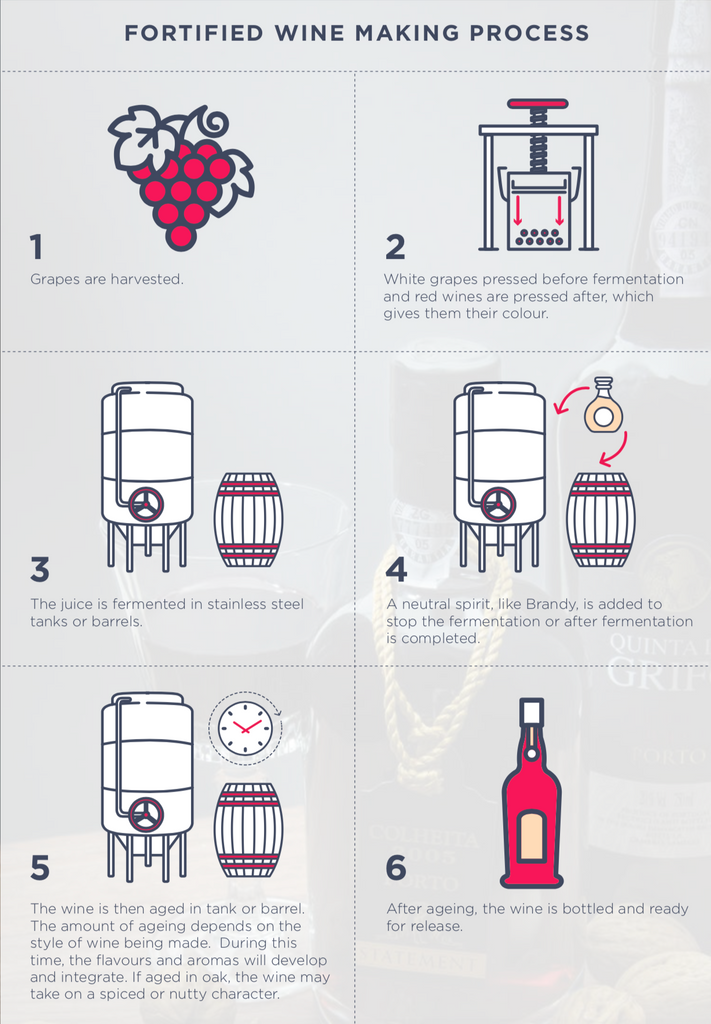by Diana Hawkins
Fortified wines are wines who have had their fermentation stopped by adding high-proof alcohol to kill off the yeast or who have had high-proof alcohol added after fermentation. The most common alcohol used to do this is brandy, but any neutral spirit will work in a pinch. Historically, this technique was used to give wines longer shelf-lives and help stabilise them for long sea voyages. Nowadays, we have better methods of transporting wines around the world. So, fortification is less of a necessity and more of a stylistic choice. Sherry and Port are two of the most popular examples of this winemaking style but there are many more! They range from bone dry and savoury to sweet and decadent, making them the perfect pairing for any meal.
Sherry
Sherry is a Spanish wine from the Jerez region of Spain. Only fortified wines made in this region can legally be called Sherry. It is mostly made from
two grape varieties with wines blended across multiple vintages, like in Champagne. The most common grape is Palomino Fino, which makes delicate, dry styles of sherry. The second is Pedro Ximénez (PX), which is dried in the sun after harvesting to concentrate its sugars. PX makes a rich, full, dark sherry.
Port
Port wines are made in the Douro Valley of Portugal. Only fortified wines made from Portugal can legally be called Port. Ports are often a blend of several different grape varieties across several vintages, like in Jerez and Champagne. The most common are the red grapes Touriga Nacional, Touriga Franca, Tinto Roriz (Tempranillo), Tinta Barroca, and Tinto Cão. There are white and rosé styles of port produced, but the majority of ports are made into a red dessert wine style. Because of its high level of both alcohol and residual sugar, Port should be “thick” with long “legs” visible on the side of the glass. There are two main styles of Port: Ruby and Tawny.
Ruby Ports are not typically aged in oak. This causes the wine to maintain its deep ruby red colour, fruity flavours, and structure. These are best drunk young.
Tawny Ports are aged in oak barrels for years, if not decades. This ageing process is what causes the brick red, tawny colour of these wines. It also contributes to the spicy, nutty flavours found in these wines. They are often released as 10, 20, or 30 Year Old Tawny. This indicates that on average, the wine has been in barrel for 10, 20, or 30 years prior to bottling. The longer the time in barrel, the more complex and heady the wine will be.
Vintage Ports are Ruby Ports that are only produced in the best years. They are designed to age for decades in bottle. At one point in time, they were popular gifts for new-born children because the wine would take at least 18 years before it was ready to drink! Upon realising the obvious financial problems with this business model, Late Bottle Vintage (LBV) Ports were developed and released as well. LBV Ports are made from the same wine as Vintage Ports but are left in barrel for a bit longer. LBV typically spend for 4 – 6 years in barrel prior to bottling compared to Vintage Port’s 1 – 3 years in cask. This makes LBV wines much more approachable and ready to drink straight away.




